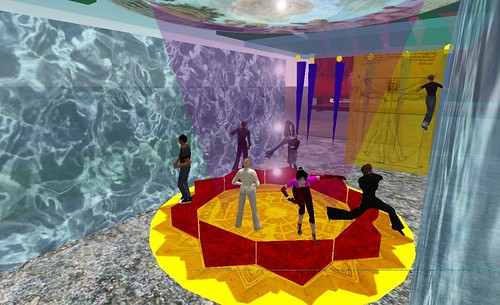(This is Alfredo Desideri’s essay submission to the Ctrl-Shift-07 competition on Lebenswelt Island – screenshots also by Alfredo)
The building’s origins date from the history of architecture: some architectural solutions therein originate from this starting point but new questions are also raised.
It is important to refer to the history of architecture, even in metaverse, because behind the avatars are human beings whose minds are used to managing their bodies in built and non-built space. The objective of architecture is always to provide and enhance pleasure in a space but also to stimulate the mind.
There are two human minds at the basis of modern life in a synthetic space: Vitruvio and Le Corbusier.
Many of their ideas still remain modern but sadly are rarely applied in real life. But could these ideas live again in the metaverse and demonstrate their full potential here?
The chosen architectural form is a temple: a place for philosophy, meeting, living and concentrating.
This is a new temple: somewhere that avatars can come together and be together.
It has cone-shaped columns that point at the ground rather than spring from it: gravity here is optional.
The walls are free-floating and their surfaces move and ripple like water.
The roof garden is a lawn that flows like a river. The triangular frontons are hedges of conical cypress and bend with the wind, just as the mind bends before external triggers.
The Modulor and the Vitruvian Man are placed at the entrances: they represent historical standards of proportions based on the human body. What purpose do they serve in the metaverse?
The plan of the fortified Venetian town of Palmanova is placed at the centre of the ground floor. It represents urban planning and could also serve as the foundation for the new metaverse architecture.
The Oculus of Mantegna, full of people and animals, is placed on the centre of the roof, with its real phantom clouds. The Oculus rotates and the avatar with it. And the avatar can sit in solitude and chat, meditate, watch the scenery and the neighbouring buildings.
The small, mobile light globes link the ground to the roof like a stairway for the mind, inviting the avatar to fly up to and through the roof, or leap towards the clouds. It is a transition from meditation to dialogue with others and vice-versa.
The Vitruvio’s directions: Firmitas, Vetustas, Venustas run along the central cornices. A question mark is near the word Firmitas…
Finally, two coloured and transparent bells are juxtaposed and superposed, like a revolving stage light in a Disney cartoon. They convey the synthetic space and recall the opposition of the real and the virtual.


